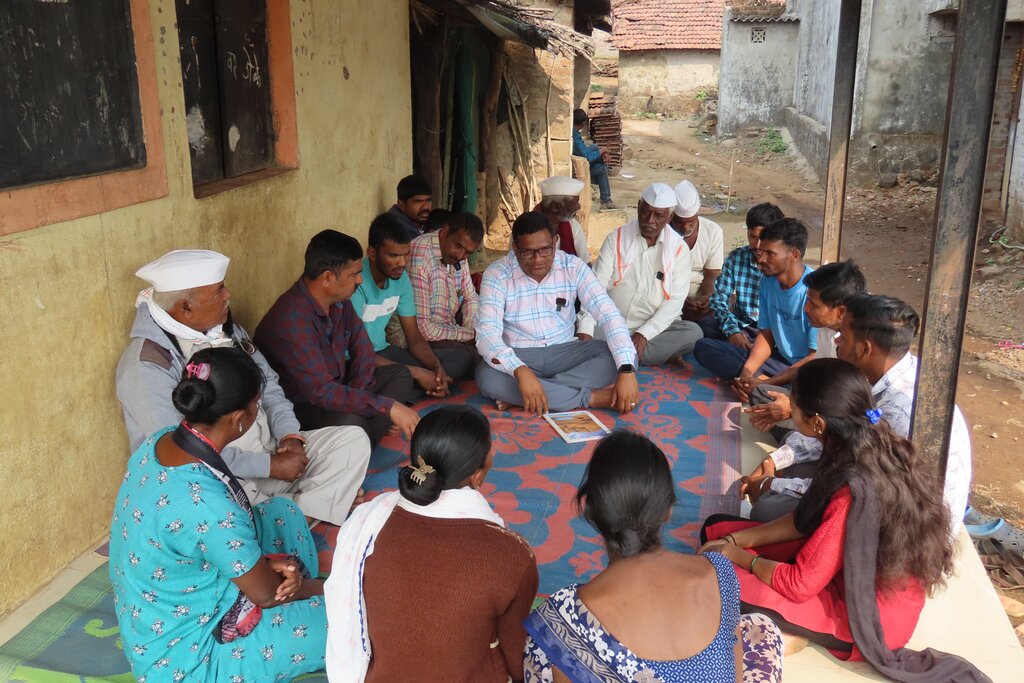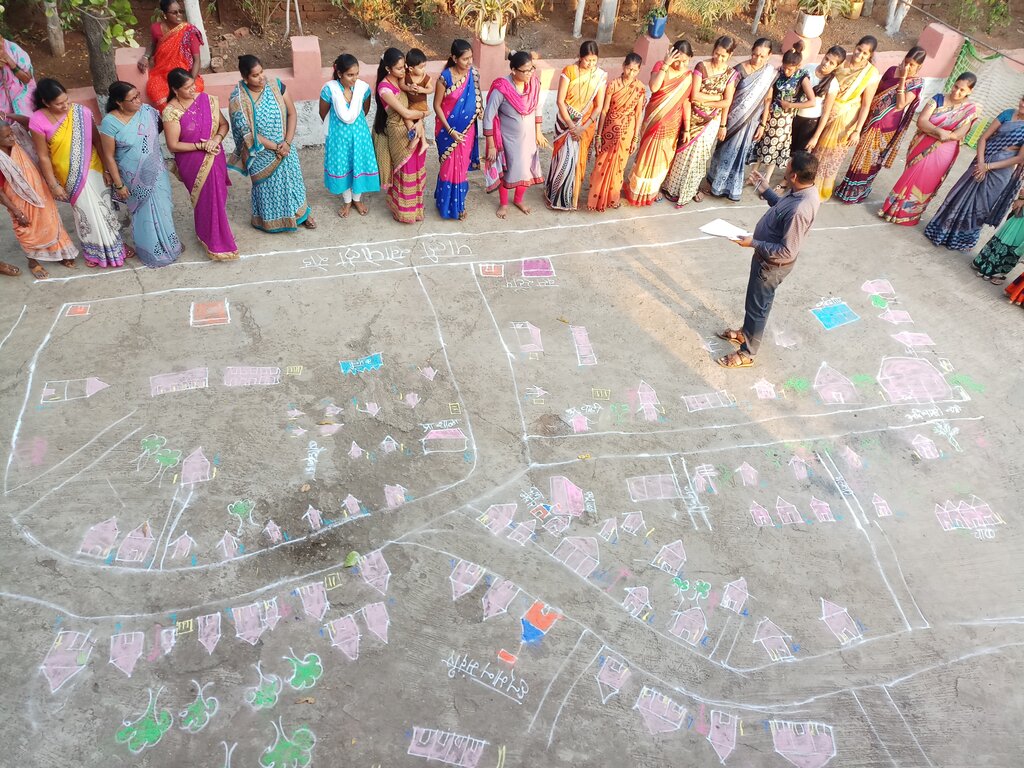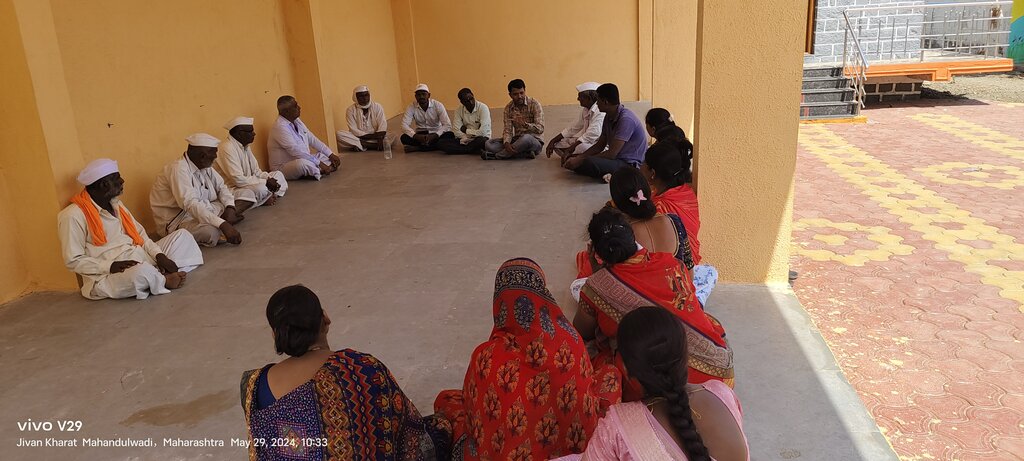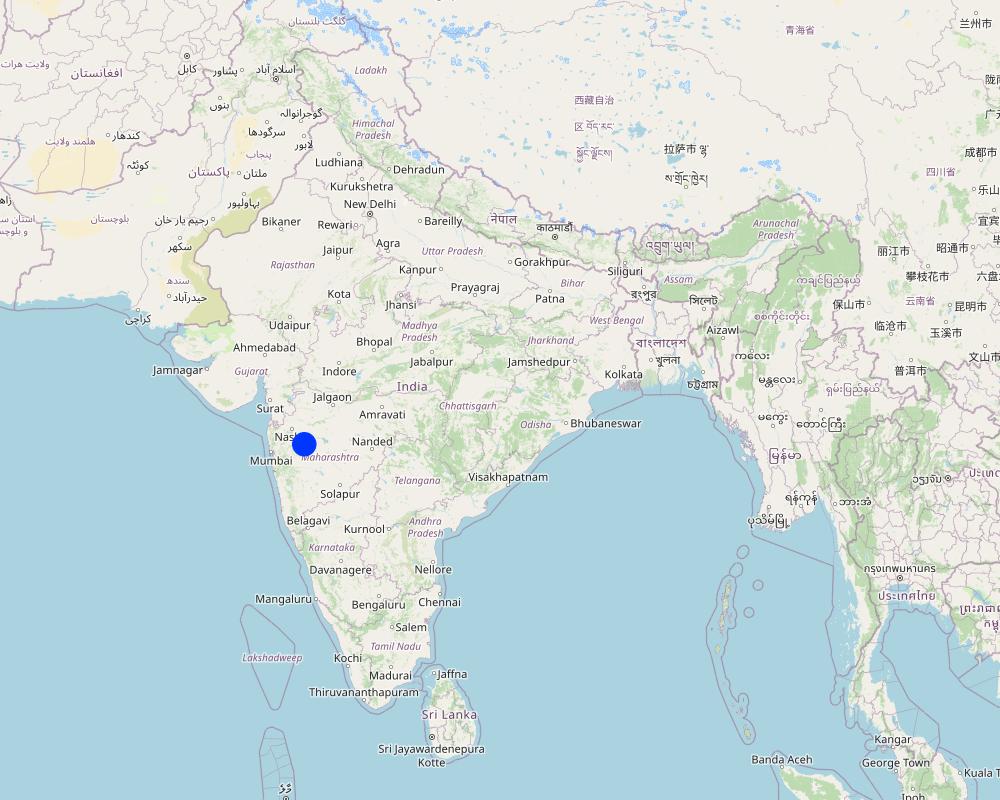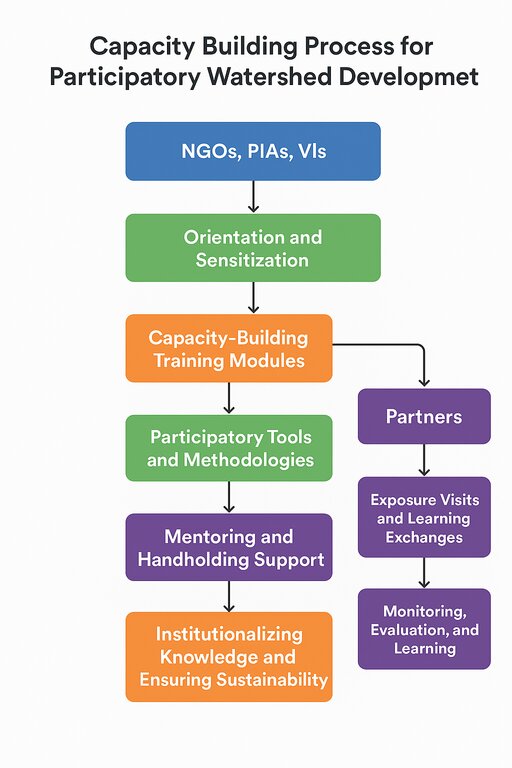Capacity Building Process for Participatory Watershed Development [India]
- Creation:
- Update:
- Compiler: Arun Bhagat
- Editor: –
- Reviewer: Udo Höggel
Community Participation in Participatory Watershed Development
approaches_7656 - India
View sections
Expand all Collapse all1. General information
1.2 Contact details of resource persons and institutions involved in the assessment and documentation of the Approach
Key resource person(s)
SLM specialist:
Rajapure Ganesh
+91 9422226412
ganesh.rajapure@wotr.org.in
Watershed Organisation Trust (WOTR)
Paryavaran Sarasnagar Road, Behind, Market Yard Road, Ahilyanagar, Maharashtra 414001
India
SLM specialist:
D’Souza Marcella
+91 9422226415
marcella.dsouza@gmail.com
W-CReS (the WOTR Centre for Resilience Studies), Watershed Organisation Trust (WOTR), Pune
The Forum, 2nd Floor, Pune - Satara Rd, above Ranka Jewellers, Padmavati Nagar, Corner, Maharashtra 411009
India
SLM specialist:
SLM specialist:
Dadas Dada
+91 9892763960
dada.dadas@wotr.org.in
W-CReS (the WOTR Centre for Resilience Studies), Watershed Organisation Trust (WOTR), Pune
The Forum, 2nd Floor, Pune - Satara Rd, above Ranka Jewellers, Padmavati Nagar, Corner, Maharashtra 411009
India
SLM specialist:
Khedkar Vishnu
+91 7798818283
vishnu.khedkar@wotr.org.in
W-CReS (the WOTR Centre for Resilience Studies), Watershed Organisation Trust (WOTR), Pune
The Forum, 2nd Floor, Pune - Satara Rd, above Ranka Jewellers, Padmavati Nagar, Corner, Maharashtra 411009
India
Name of the institution(s) which facilitated the documentation/ evaluation of the Approach (if relevant)
Watershed Organisation Trust (WOTR) - India1.3 Conditions regarding the use of data documented through WOCAT
When were the data compiled (in the field)?
24/09/2025
The compiler and key resource person(s) accept the conditions regarding the use of data documented through WOCAT:
Yes
2. Description of the SLM Approach
2.1 Short description of the Approach
The Capacity Building Process for Participatory Watershed Development is a structured approach to strengthen the technical, managerial, and social skills of Non-Governmental Organizations (NGOs), Partner Implementation Agencies (PIAs), and Village-level Institutions (VIs). It includes orientation, training, participatory tools, mentoring, exposure visits, monitoring, and institutionalization. The process enhances competencies, fosters creativity and confidence, promotes community ownership, and ensures effective, sustainable planning, implementation, and management of watershed-based natural resource management and climate-resilient interventions.
2.2 Detailed description of the Approach
Detailed description of the Approach:
Capacity Building Process for Participatory Watershed Development:
Many Non-Governmental Organizations (NGOs), Partner Implementation Agencies (PIAs), and Village-level Institutions (VIs) aspire to implement participatory natural resource management (NRM) using a watershed approach. However, they often lack the technical expertise, practical skills, and experience needed for effective implementation. To address this gap, a structured capacity-building and induction strategy is essential. Such a strategy strengthen the technical and managerial competencies, nurtures creativity, and enhances their confidence to plan, implement, and sustain watershed interventions. In turn, it transforms their approach to resource mobilization, management, and sustainability. A common environmental challenge—such as water scarcity, land degradation, and climate change—creates opportunities to unite communities around shared needs. The Watershed Organisation Trust (WOTR) has effectively used watershed development as a unifying framework to bring people together, encouraging collective action for improving livelihoods and building resilience—especially among the poor and vulnerable.
Purpose of Capacity Building:
The overarching goal of the capacity-building process is to develop the knowledge, skills, attitudes, and confidence of NGOs, PIAs, and VIs in designing, implementing, and sustaining participatory, watershed-based NRM and climate-resilient development interventions.
Expected Outcomes:
•Improved competence in managing watershed-based NRM and climate change adaptation.
•Strengthened community ownership and participation.
•Effective and sustainable implementation of interventions.
•Positive transformation in approaches to resource mobilization and local governance.
Methodology and Key Steps:
The capacity-building approach comprises a series of interlinked steps, each reinforcing the others. Together, they form a comprehensive and adaptive learning process.
Step 1: Orientation and Sensitization
Objective: Build a common understanding and motivation among all project stakeholders.
Approach:
•Conduct orientation sessions explaining linkages between natural resources, livelihoods, and resilience.
•Share success stories and best practices to inspire commitment.
•Define roles and responsibilities of community-based organizations and NGOs.
Step 2: Capacity-Building Training Modules
Objective: Strengthen technical and managerial skills, especially among field-level stakeholders.
Core Modules:
•Technical Skills: Soil and water conservation, water budgeting, sustainable agriculture, climate resilience, and ecosystem-based adaptation.
•Social & Institutional Development: Social mobilization, gender inclusion, facilitation, group dynamics, and strengthening local institutions.
•Project Management: Planning, budgeting, reporting, and monitoring for effective implementation.
Step 3: Participatory Tools and Methodologies
Objective: Equip local groups with practical tools for participatory planning and action.
Tools and Methods:
•Participatory Rural Appraisal (PRA) tools such as resource mapping, seasonal calendars, and wealth ranking.
•Participatory Net Planning (PNP) for micro-level watershed planning.
•Use of digital tools and simple MIS platforms for data management and progress tracking.
Step 4: Mentoring and Handholding Support
Objective: Ensure continued learning, quality implementation, and motivation.
Approach:
•On-site technical and managerial guidance by experienced facilitators or resource NGOs.
•Regular review and feedback meetings to troubleshoot challenges.
•Peer learning and cross-visits among different project sites for shared learning.
Step 5: Exposure Visits and Learning Exchanges
Objective: Promote experiential and peer-to-peer learning.
Approach:
•Organize visits to successful watershed and NRM sites.
•Facilitate interactions with experienced community institutions and farmer groups.
•Encourage farmer-to-farmer extension to build local confidence and innovation.
Step 6: Monitoring, Evaluation, and Learning (MEL)
Objective: Foster accountability, reflection, and adaptive learning.
Approach:
•Train partners in participatory monitoring, data collection, documentation, and reporting.
•Develop and use simple, participatory monitoring tools to track outcomes and learning.
•WOTR’s existing participatory MEL tools are adapted for partners to ensure consistent data and insights.
Step 7: Institutionalizing Knowledge and Ensuring Sustainability
Objective: Build long-term local ownership and reduce dependence on external support.
Approach:
•Develop local resource persons, for example para-professionals.
•Establish local training and resource centers for continuous on-the-ground support.
•Document best practices, lessons learned, and local innovations for knowledge sharing.
•Gradually transfer leadership and responsibility to community institutions.
2.3 Photos of the Approach
General remarks regarding photos:
Photos of activities like resource mapping are important as they visually document community participation, local knowledge, and the planning process. They help capture the involvement of villagers, the use of PRA tools, and the mapping outcomes. Such photos serve as powerful evidence of participatory planning, support monitoring and reporting, and effectively communicate project processes and impacts to stakeholders and partners.
2.5 Country/ region/ locations where the Approach has been applied
Country:
India
Region/ State/ Province:
Maharashtra, MadhyaPradesh, Telangana, Karnataka, Jharkhand, Odisha, Chhattisgarh states
Further specification of location:
Ahilyanagar, Jalna, Hyderabad, Sanga Reddy, Mandala, Gajapati, Rayagada, and more, etc.
Comments:
Watershed Organisation Trust (WOTR), established in 1993, has been actively engaged in capacity building since its inception (Stared from this location). This participatory approach continues to be implemented in WOTR-supported villages across nine states in India.
Map
×2.6 Dates of initiation and termination of the Approach
If precise year is not known, indicate approximate date when the Approach was initiated:
10-50 years ago
Comments:
Year of termination is not applicable because capacity building is essential in participatory watershed management.
2.7 Type of Approach
- The capacity-building process (approach) combines traditional and indigenous knowledge, recent local innovations, and project or program-based approaches for effective and sustainable watershed management.
2.8 Main aims/ objectives of the Approach
The main aims/objectives of the Capacity Building Process for Participatory Watershed Development are
• Strengthen technical, social, and managerial skills of NGOs, PIAs, and Village-level Institutions for effective watershed management.
• Promote participatory planning, community ownership, and active engagement in watershed interventions.
• Build project management capacity, including planning, budgeting, monitoring, and reporting.
• Support continuous learning through mentoring, exposure visits, and peer exchanges.
• Ensure sustainability by institutionalizing knowledge, developing local resource persons, and transferring leadership to communities.
2.9 Conditions enabling or hindering implementation of the Technology/ Technologies applied under the Approach
social/ cultural/ religious norms and values
- enabling
Living together for a common purpose forms the foundation of society. A strong sense of ownership and active participation is essential for achieving sustainable development.
availability/ access to financial resources and services
- enabling
Transparency acts as a social audit, it serves as an effective tool for accountability and openness.
institutional setting
- enabling
It provides a platform for community members to develop and exercise leadership.
collaboration/ coordination of actors
- enabling
It forms the foundation for building strong and sustainable institutions.
- hindering
Conflicts may arise among community members due to differing opinions, taboos, or perceptions.
legal framework (land tenure, land and water use rights)
- enabling
Village-level Institutions (VIs) are linked with the local governing body, i.e., the Village Panchayat.
policies
- enabling
It facilitates the process of social auditing.
land governance (decision-making, implementation and enforcement)
- enabling
It enhances community participation in planning and implementation.
knowledge about SLM, access to technical support
- enabling
Through training that provides technical knowledge on the project’s key components.
markets (to purchase inputs, sell products) and prices
- enabling
Training materials can be procured.
workload, availability of manpower
- enabling
Provides local animators to assist in project implementation.
3. Participation and roles of stakeholders involved
3.1 Stakeholders involved in the Approach and their roles
- local land users/ local communities
Farmers, Women, and Youth
Consent to work, willingness to participate in mobilization activities, and attendance at capacity-building events.
- community-based organizations
Men, Women, and Local Representatives
Making informed decisions and managing conflicts effectively. Encouraging active community participation, carefully selecting beneficiaries, and monitoring the impacts of interventions.
- SLM specialists/ agricultural advisers
NGO staff and team members
Planning, implementing, and monitoring activities
- researchers
Researchers and community members (men and women) involved in planning, implementation, and impact monitoring
Researchers design and guide training activities, facilitate knowledge sharing, provide technical expertise, monitor progress, and assess the impact of interventions to strengthen the skills and capacities of communities and stakeholders.
- teachers/ school children/ students
School and nursery teachers.
Facilitating learning, guiding children, and supporting community education initiatives
- NGO
Board members
Board resolution
- private sector
Technical Expert - Individual or Group
Support to the SLM specialist
- local government
Gram Panchayat (PRI)
Local governance body
Necessary resolutions
- national government (planners, decision-makers)
Concern Departments
Content and Guidelines for Capacity-Building Efforts
- international organization
Donor Agencies
Content and Guidelines for Capacity-Building Efforts
Funding, technical support, and guidance for community development and capacity-building initiatives
If several stakeholders were involved, indicate lead agency:
The main implementing agency will take the lead role in planning, coordinating, and executing the activities (Capacity-building processes are closely linked to project implementation, so the project’s nodal agency takes the lead role).
3.2 Involvement of local land users/ local communities in the different phases of the Approach
| Involvement of local land users/ local communities | Specify who was involved and describe activities | |
|---|---|---|
| initiation/ motivation | self-mobilization | Community members need to demonstrate their willingness to actively participate in project planning and implementation. |
| planning | interactive | Farmers, CBO (Community-Based Organisation) members, women, and village-level animators actively participate in planning and review meetings, and contribute by passing resolutions in CBO meetings. |
| implementation | interactive | Farmers, CBO members, women, and the project team actively participate in executing activities and in collecting relevant contributions. |
| monitoring/ evaluation | interactive | CBO members participate in joint monitoring visits and share information for impact documentation and research studies. |
| interactive |
3.3 Flow chart (if available)
Description:
This visual is illustrating a Capacity Building Process for Participatory Watershed Development using a step-by-step flowchart.
It starts with key implementing institutions such as NGOs, PIAs, and Village Institutions (VIs). The process begins with Orientation and Sensitization, followed by Capacity-Building Training Modules that strengthen skills and technical knowledge. From here, the approach branches into two parallel components:
1. Participatory Tools and Methodologies → enabling communities to actively take part in planning and decision-making.
2. Partners → supporting collaboration through exposure visits and knowledge sharing.
The next stage provides Mentoring and Handholding Support to guide field-level implementation.
Finally, the process moves to Institutionalizing Knowledge and Ensuring Sustainability, ensuring that skills, systems, and learnings remain within the community for long-term development impact. Overall, the diagram shows a structured learning pathway that builds capacity, supports practical application, and ensures sustainable watershed management.
Author:
Dr. Arun Bhagat
3.4 Decision-making on the selection of SLM Technology/ Technologies
Specify who decided on the selection of the Technology/ Technologies to be implemented:
- all relevant actors, as part of a participatory approach
Explain:
The NGO plays a leading role in initiating the process, while community members become actively involved as the process progresses.
Specify on what basis decisions were made:
- evaluation of well-documented SLM knowledge (evidence-based decision-making)
4. Technical support, capacity building, and knowledge management
4.1 Capacity building/ training
Was training provided to land users/ other stakeholders?
Yes
Specify who was trained:
- land users
- field staff/ advisers
If relevant, specify gender, age, status, ethnicity, etc.
Community members of all age groups.
Form of training:
- on-the-job
- farmer-to-farmer
- demonstration areas
- public meetings
Subjects covered:
Key concepts and topics include: Environmental degradation, Natural Resource Management, Watershed Development, Participatory planning and monitoring tools, Community participation and contributions, Role of stakeholders, Portfolio management, Women empowerment, Gender inclusion, Sustainable agriculture, and Post-project management.
Comments:
Training modules are designed to meet the specific needs of the project and location.
4.2 Advisory service
Do land users have access to an advisory service?
Yes
Specify whether advisory service is provided:
- on land users' fields
Describe/ comments:
In today’s era of climate change and volatile markets, Indian farmers face growing challenges that affect productivity and food security. Unlike urban areas that benefit from the digital revolution, rural farmers need timely, localized, and actionable information on sustainable farming practices. WOTR’s FarmPrecise app addresses this need, providing a comprehensive, data-driven tool to support informed agricultural decisions. Previously, WOTR developed an Agromet Advisory System delivering crop- and location-specific advisories via SMS using data from the India Meteorological Department (IMD). While valuable for weather forecasts, this system lacked personalization and direct farmer engagement.
WOTR launched the FarmPrecise app in 2019 to provide dynamic, farm-specific advisories. Since then, it has grown substantially, with over 1 lakh downloads, covering 30 crops across the Indian States of Maharashtra, Telangana, Odisha, and Madhya Pradesh, and is available in five languages: English, Hindi, Marathi, Telugu, and Odia.
4.3 Institution strengthening (organizational development)
Have institutions been established or strengthened through the Approach?
- yes, greatly
Specify the level(s) at which institutions have been strengthened or established:
- local
Describe institution, roles and responsibilities, members, etc.
Village Development Committee (VDC): Responsible for planning and executing project activities, selecting beneficiaries and work sites, managing conflicts, overseeing community contributions, ensuring quality supervision and monitoring, maintaining records, and conducting social audits.
Self-Help Groups (SHGs): Organize women into savings and credit groups and manage SHG operations.
Village Water Management Team: Promote water budgeting, coordinate water governance, and support sustainable water management practices.
Specify type of support:
- capacity building/ training
Give further details:
Capacity-building inputs are delivered in a sequence of trainings aligned with the project cycle tenure.
4.4 Monitoring and evaluation
Is monitoring and evaluation part of the Approach?
Yes
Comments:
In regular Community-Based Organization (CBO) trainings, the monitoring component is a key focus area.
If yes, is this documentation intended to be used for monitoring and evaluation?
Yes
Comments:
It is used for follow-up purposes as well as for knowledge dissemination.
4.5 Research
Was research part of the Approach?
Yes
Specify topics:
- sociology
- economics / marketing
- ecology
- technology
Give further details and indicate who did the research:
The baseline survey tool is used for impact documentation. It helps reach beneficiaries to record their quality of life and assess the effects of project activities.
5. Financing and external material support
5.1 Annual budget for the SLM component of the Approach
If precise annual budget is not known, indicate range:
- < 2,000
Comments (e.g. main sources of funding/ major donors):
Main sources of funding / major donors: National and international donors, and Corporate Social Responsibility (CSR) contributions.
5.2 Financial/ material support provided to land users
Did land users receive financial/ material support for implementing the Technology/ Technologies?
Yes
If yes, specify type(s) of support, conditions, and provider(s):
Although not through direct financial or material support, land users (community) benefit from improved skills and knowledge, and gain advantages through active participation and involvement.
5.3 Subsidies for specific inputs (including labour)
- none
If labour by land users was a substantial input, was it:
- voluntary
Comments:
While labor is not required, participation of land users in the capacity-building process is essential. Landowners contribute their knowledge and time to share ideas and insights.
5.4 Credit
Was credit provided under the Approach for SLM activities?
No
5.5 Other incentives or instruments
Were other incentives or instruments used to promote implementation of SLM Technologies?
No
6. Impact analysis and concluding statements
6.1 Impacts of the Approach
Did the Approach empower local land users, improve stakeholder participation?
- No
- Yes, little
- Yes, moderately
- Yes, greatly
Greater awareness and better understanding of project management and its impact on project components led to higher participation
Did the Approach enable evidence-based decision-making?
- No
- Yes, little
- Yes, moderately
- Yes, greatly
The progress of project components is presented in common meetings, such as Gram Sabhas, enabling CBO members to make informed decisions.
Did the Approach help land users to implement and maintain SLM Technologies?
- No
- Yes, little
- Yes, moderately
- Yes, greatly
Active and well-informed participation in planning, execution, and ensuring quality work.
Did the Approach improve coordination and cost-effective implementation of SLM?
- No
- Yes, little
- Yes, moderately
- Yes, greatly
Capacity building produces synergistic outcomes.
Did the Approach mobilize/ improve access to financial resources for SLM implementation?
- No
- Yes, little
- Yes, moderately
- Yes, greatly
The participatory Net Planning (PNP) tool in support of capacity building approach facilitates proper land-use planning with budget allocation for specific plots.
Did the Approach improve knowledge and capacities of land users to implement SLM?
- No
- Yes, little
- Yes, moderately
- Yes, greatly
Capacity building activities and net planning exercises provide inputs on the technical know-how of watershed structures.
Did the Approach improve knowledge and capacities of other stakeholders?
- No
- Yes, little
- Yes, moderately
- Yes, greatly
The capacity-building approach improved stakeholders’ knowledge and skills through training, hands-on exercises, participatory planning, and active involvement in decision-making.
Did the Approach build/ strengthen institutions, collaboration between stakeholders?
- No
- Yes, little
- Yes, moderately
- Yes, greatly
The capacity-building process brings all stakeholders onto a common platform, fostering a shared vision, sustainable impact, and resilience.
Did the Approach mitigate conflicts?
- No
- Yes, little
- Yes, moderately
- Yes, greatly
It helps unite the community and reduces conflicts related to resource management.
Did the Approach empower socially and economically disadvantaged groups?
- No
- Yes, little
- Yes, moderately
- Yes, greatly
The principle of equity was upheld during the capacity-building process, with community members from all sectors actively involved and given equal representation in CBO and VI structures.
Did the Approach improve gender equality and empower women and girls?
- No
- Yes, little
- Yes, moderately
- Yes, greatly
Special emphasis was placed on women, with a separate Plan of Participation (POP) developed to ensure their inclusion and promote gender equity.
Did the Approach encourage young people/ the next generation of land users to engage in SLM?
- No
- Yes, little
- Yes, moderately
- Yes, greatly
Special focus was placed on engaging youth in the net planning process to ensure their active participation in local support and supervision.
Did the Approach improve issues of land tenure/ user rights that hindered implementation of SLM Technologies?
- No
- Yes, little
- Yes, moderately
- Yes, greatly
Informal land user issues are resolved during the implementation process.
Did the Approach lead to improved food security/ improved nutrition?
- No
- Yes, little
- Yes, moderately
- Yes, greatly
A well-designed capacity-building process ensures quality implementation, leading to better outcomes.
Did the Approach improve access to markets?
- No
- Yes, little
- Yes, moderately
- Yes, greatly
Market-related inputs are included in the training modules.
Did the Approach lead to improved access to water and sanitation?
- No
- Yes, little
- Yes, moderately
- Yes, greatly
A well-designed capacity-building process leads to quality implementation, resulting in positive outcomes.
Did the Approach lead to more sustainable use/ sources of energy?
- No
- Yes, little
- Yes, moderately
- Yes, greatly
The capacity-building approach promoted sustainable energy use by training stakeholders on efficient practices, demonstrating renewable technologies, and encouraging participatory planning for optimal resource use.
Did the Approach improve the capacity of the land users to adapt to climate changes/ extremes and mitigate climate related disasters?
- No
- Yes, little
- Yes, moderately
- Yes, greatly
A well-designed capacity-building process, combined with effective training, ensures quality implementation, leading to positive outcomes and impacts, while enhancing individuals’ resilience through adaptation.
Did the Approach lead to employment, income opportunities?
- No
- Yes, little
- Yes, moderately
- Yes, greatly
Improved agriculture creates both on-farm and off-farm livelihood opportunities.
6.2 Main motivation of land users to implement SLM
- increased production
Enhanced soil moisture and soil quality, along with increased awareness and adoption of improved agricultural practices.
- reduced land degradation
Reduced soil erosion and land degradation, along with improved knowledge of water and land management practices.
- rules and regulations (fines)/ enforcement
Land users practice and uphold equality at all levels.
- environmental consciousness
Integration of climate change–related topics into capacity-building strategies.
- enhanced SLM knowledge and skills
A structured and systematic process for implementing Sustainable Land Management (SLM) practices.
6.3 Sustainability of Approach activities
Can the land users sustain what has been implemented through the Approach (without external support)?
- yes
If yes, describe how:
The principle of ‘learning by doing’ is central to the capacity-building process. Communities gain hands-on experience in various project components, developing strong technical and managerial skills at the local level. This enhances sustainability, as trained village institutions such as VDC members and community workers possess the necessary knowledge and skills for continued implementation and impact documentation.
6.4 Strengths/ advantages of the Approach
| Strengths/ advantages/ opportunities in the land user’s view |
|---|
| Inclusion of Indigenous Knowledge: The approach allows local and traditional knowledge to be integrated into planning and implementation, making interventions more relevant and practical to the local context. |
| Enhanced Knowledge on NRM: Land users gain valuable knowledge and information about Natural Resource Management (NRM), helping them make informed decisions on soil, water, and land use practices. |
| Leadership Development: Community members get opportunities to take leadership roles in planning and decision-making processes, strengthening local governance and ownership. |
| Social Inclusion: The process ensures participation from all sections of society, including marginalized groups, women, and youth, promoting equity and collective action. |
| Strengths/ advantages/ opportunities in the compiler’s or other key resource person’s view |
|---|
| Systematic Approach: The capacity-building process follows a structured and step-by-step framework, ensuring consistency, clarity, and efficiency in planning, implementation, and monitoring. |
| Tested and Proven Strategy: The approach is based on field-tested methodologies and past experiences, which have demonstrated successful outcomes in participatory watershed and NRM projects. |
| Operational Guidelines: Well-defined operational guidelines provide a clear roadmap for facilitators and implementing agencies, helping to standardize procedures and maintain quality across different project sites. |
| Set of Tools: The process includes a comprehensive toolkit—such as participatory planning tools, training modules, and monitoring formats—which helps streamline learning, participation, and evaluation. |
6.5 Weaknesses/ disadvantages of the Approach and ways of overcoming them
| Weaknesses/ disadvantages/ risks in the land user’s view | How can they be overcome? |
|---|---|
| Time Constraints: The capacity-building process requires continuous engagement, which can be time-consuming and may interfere with regular livelihood activities of land users. |
Flexible Organization of Capacity-Building (CB) Events: Conduct training and awareness sessions at times and locations convenient for community members to ensure higher participation, especially for women and farmers with field responsibilities. Use of Social Media and Digital Platforms: Share project updates, training materials, and success stories through WhatsApp groups, community radio, and other social media tools to reach a wider audience effectively. |
| Lack of Confidence to Participate: Some community members, especially those with limited education or exposure, may initially hesitate to engage actively in discussions or decision-making. |
Rapport Building: Establishing trust and positive relationships with community members helps facilitators engage participants more effectively and encourages open communication. Interactive Methods – Games, Exercises, Personal Talks, and Corner Meetings: Use participatory and informal methods to make learning enjoyable, build confidence, and promote active involvement among community members. Use of Participatory Rural Appraisal (PRA) Tools: PRA methods like mapping, ranking, and seasonal calendars help participants express local knowledge and experiences, increasing confidence and ownership in the planning process. |
| Social Constraints and Gender Barriers: Cultural taboos and social norms may restrict women’s participation in meetings or leadership roles, limiting their ability to contribute fully to capacity-building and project implementation. |
Encouraging attendance and use of Information: Motivate community members to regularly attend meetings, apply shared knowledge in their practices, and contribute ideas for better project outcomes. Confidence Building Among Men and Women: Conduct targeted sessions to enhance the confidence of both men and women, ensuring balanced participation and reducing gender-based hesitation in community discussions. |
| Weaknesses/ disadvantages/ risks in the compiler’s or other key resource person’s view | How can they be overcome? |
|---|---|
| Language and Cultural Barriers: Differences in language and cultural practices can make it difficult to communicate technical concepts effectively, especially in diverse and multi-lingual communities. | Rapport Building and Understanding of the Community: Spend adequate time in the field to understand local culture, traditions, and social dynamics. Building mutual trust enhances participation and improves the quality of capacity-building interventions. |
| Limited Literature in Local Language: The scarcity of training materials and technical documents in local languages restricts understanding and limits wider participation at the grassroots level. | Translation of Reading and Training Materials: Translate manuals, handouts, and key reference materials into local languages to make technical content accessible to all community members and ensure uniform understanding. |
| Communication and Facilitation Skills: Successful capacity building depends on skilled facilitators. In some cases, inadequate communication or facilitation skills among trainers can reduce the effectiveness of training sessions and field interactions. | Upgrading Skills of Trainers and Facilitators: Provide regular refresher training and exposure opportunities for facilitators to enhance their communication, facilitation, and technical skills—ensuring more effective delivery of capacity-building programs. |
7. References and links
7.1 Methods/ sources of information
- field visits, field surveys
Two field visits are conducted to engage the village community in discussions on the capacity-building process, its impact, importance, and role in fostering ownership.
- interviews with land users
Interviews were conducted with six land users.
- interviews with SLM specialists/ experts
Interviews were conducted with five land users.
- compilation from reports and other existing documentation
The information is sourced from a capacity-building methodology that has been developed and is currently under publication.
7.2 References to available publications
Title, author, year, ISBN:
WATERSHED DEVELOPMENT GUIDELINES (Revised 2001), Community and Rural Development Department,
Available from where? Costs?
https://megcnrd.gov.in/forms/WSD.pdf
Title, author, year, ISBN:
The Wasundhara Approach. 2013. Watershed Organisation Trust (WOTR).
Available from where? Costs?
https://www.yumpu.com/en/document/read/19427351/the-wasundhara-approach-wotr
7.3 Links to relevant information which is available online
Title/ description:
Wasundhara Approach, Watershed Organisation Trust (WOTR)
URL:
https://www.youtube.com/watch?v=r3YHpkm9qFY&t=364s
Title/ description:
Water Gives Life, Watershed Organisation Trust (WOTR)
URL:
https://www.youtube.com/watch?v=thdevpZ-vio&t=149s
Title/ description:
How to do Wealth Ranking in Watershed
URL:
https://www.youtube.com/watch?v=ygiAy7f7Gpc
Title/ description:
Wasundhara
URL:
https://www.youtube.com/watch?v=r3YHpkm9qFY&t=364s
Title/ description:
A New Beginning
URL:
https://www.youtube.com/watch?v=LBzF7DXbedM&t=2s
Title/ description:
Rising Together: Building Resilient Communities for a Sustainable Tomorrow
URL:
https://www.youtube.com/watch?v=0gCFkwkfwdg&t=2s
Links and modules
Expand all Collapse allLinks
No links
Modules
No modules



